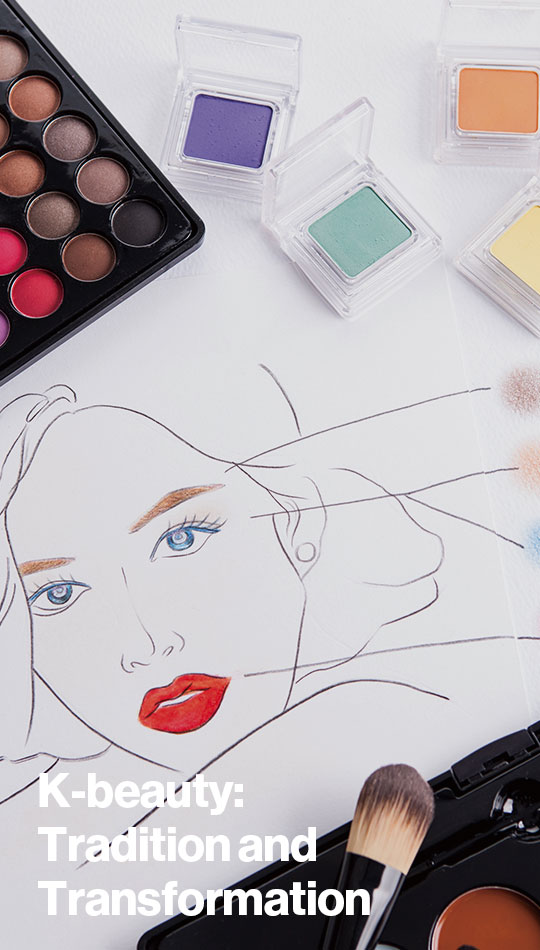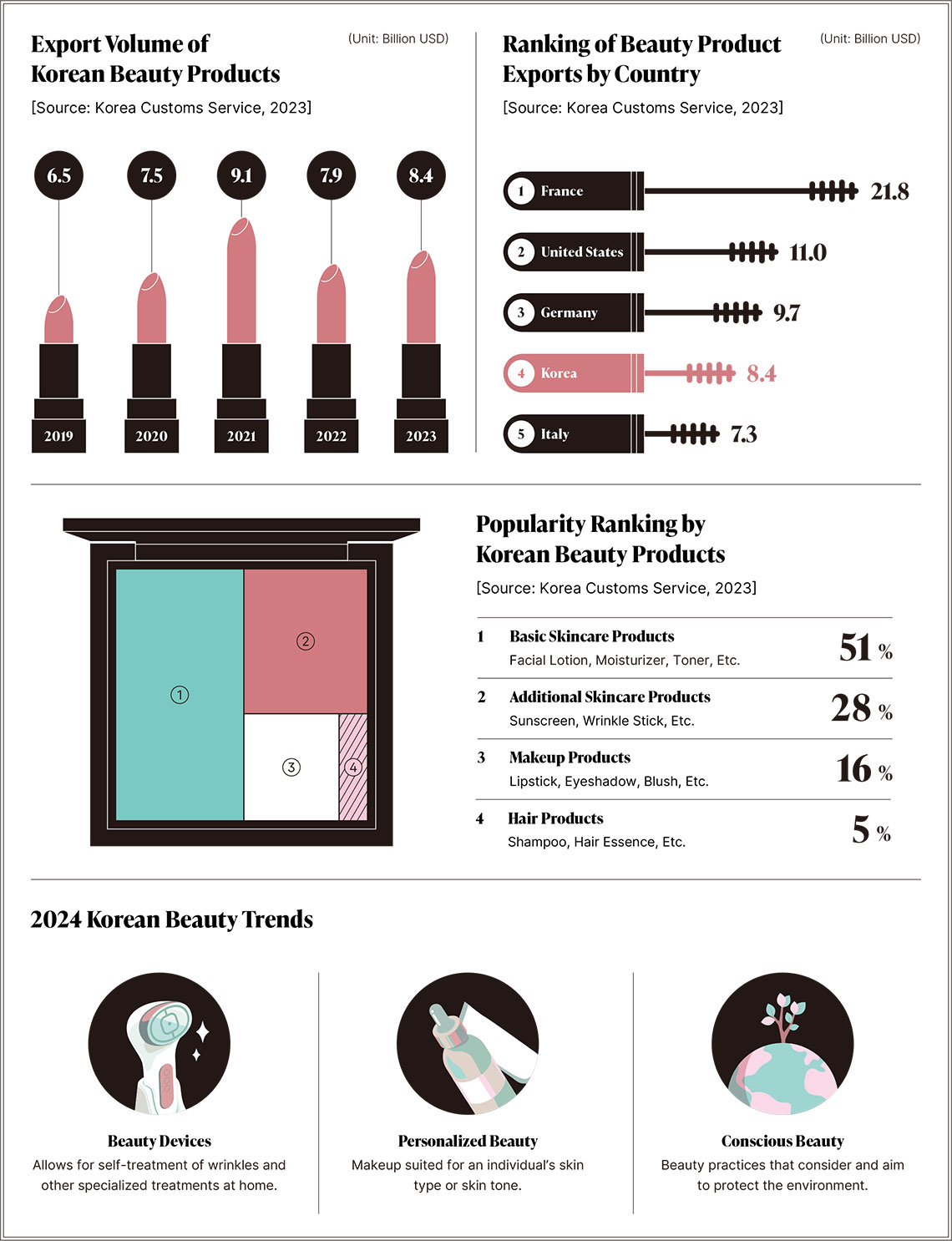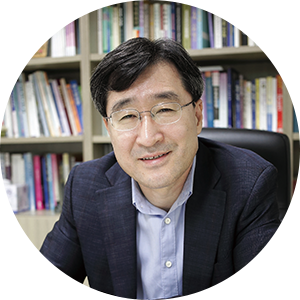Korean beauty products and beauty culture, known as K-beauty, have gained global recognition as an aspect of Hallyu, or the Korean Wave. The success of K-beauty abroad can be traced back to the cosmetics culture of prehistoric Koreans, traditions that are augmented by contemporary techniques. Ancient K-beauty traditions passed down for centuries have helped Korea to become one of the world’s three biggest exporters of cosmetics. K-beauty is not merely about outward beauty, but also encompasses traditions and sociocultural values. Korean beauty products are regarded as an original and sustainable solution in the global market. Innovative K-beauty products are grounded in the country’s historical background and an understanding of natural materials.


Writer. Kim Ju-deok
Cultural Foundations of
K-beauty
The Korean word for “beautiful” (areumdapda) can be used not only to describe someone’s physical appearance but also to admire their inner worth and to laud sociocultural values. In our contemporary society, the abstract concept of beauty has become an industry of its own, playing an even greater role in our lives. But this is a moment when we should reflect upon the true aesthetic meaning of “beauty.” We shouldn’t view K-beauty as merely piggy-backing on the success of Korean dramas and K-pop. That would be to disregard K-beauty’s roots in a historical and traditional understanding of beauty.
In Korean history, beauty goes beyond mere physical characteristics and is defined as an expression of inner strength and resilience. Under traditional values, physical training was about more than maximizing one’s looks―it was also regarded as a way to cultivate the mind.
The historical origins of K-beauty can be found in the mythical foundation of Gojoseon, considered the first kingdom on the Korean Peninsula. According to legend, a bear and a tiger sought to become human beings by eating garlic and mugwort. These ingredients have cosmetic properties, suggesting that people of the time used garlic and mugwort as skin-whitening agents.
Cosmetic culture developed even further in the Three Kingdoms Period (57 BCE~668 CE). Sophisticated practices flourished in the three competing kingdoms of Goguryeo, Baekje and Silla, reflecting their distinct cultures. The Silla custom of only selecting people of wisdom, beauty and courage as leaders was also adopted in the organizations of undaunted young soldiers.
During the subsequent Goryeo and Joseon Dynasties, attitudes toward beauty shifted to privilege mental fortitude over physical charm under the ruling ideology of Confucianism. But the practice of cultivating the mind by emphasizing cleanliness and neatness has survived into the present day.
 1. In 1916, Parkgabun was introduced as Korea’s first branded cosmetic product. It gained popularity due to rumors of its excellent whitening effect, satisfying customers with its affordable price and fragrance. / © SEOUL MUSEUM OF HISTORY
1. In 1916, Parkgabun was introduced as Korea’s first branded cosmetic product. It gained popularity due to rumors of its excellent whitening effect, satisfying customers with its affordable price and fragrance. / © SEOUL MUSEUM OF HISTORY2. Amorepacific’s ABC Powder No. 1, which contained finely milled powder made with the ‘Airspun,’ an innovative high-performance micronizer from the 1960s / © Amorepacific.
Through the Whirlwind of War
The Korean cosmetics market opened up to other cultures earlier than other industries and has long competed with foreign firms for the best techniques. Japanese brands dominated the Korean market during the colonial era (1910~1945), and Western cosmetic products reached Korea via U.S. military bases during the Korean War (1950~1953), threatening the very survival of local brands. In 1983, the government took steps to liberalize imports, letting in a flood of products from overseas. That also had a major impact on the cosmetics market.
Western cosmetic methods were first introduced to Korea in the Gyeongseong Exposition in 1870, Korea’s first cosmetics exhibition. The first cosmetics brand in the country, called Bakgabun (meaning “Park family powder”), was launched in 1915 by Jeong Jeong-suk, wife of Park Seung-jik. Jeong took inspiration from an old market woman selling face powder she had made. Bakgabun became quite popular both because of its portable carrying case and because of the striking logo based on the Park family name. Soon, copycats appeared in the market such as Seogabun (Seo family powder) and Janggabun (Jang family powder).
The 1930s were a vibrant time for the cosmetics market with the emergence of cosmetics companies such as Pacific Chemical (which later became Amorepacific), Taeyangni Chemicals and Dongbo Chemicals. But the market soon faltered because of rigid controls by the Japanese colonial administration.
Following Korea’s liberation, the cosmetics industry enjoyed another boom, and the industry persevered even amid the Korean War. Pacific Chemical, which relocated from Seoul to Busan after the war, staffed its research team with graduates of overseas universities and the pharmacy program of the nation’s top university, Seoul National University. The company continued to forge ahead, launching domestic production of face powder through a technological partnership with French company Coty.
The growth of the cosmetics industry also brought more women into the workforce. In the 1960s, Pacific Chemical’s new brand “Amore” became a big success through the revolutionary distribution method of door-to-door sales. While that was launched with the goal of eliminating the cosmetic knockoffs that were prevalent at the time, it also helped counteract the stigma against women having careers, along with creating numerous jobs in the cosmetics and beauty industries.
 In 1972, Amorepacific held the ‘Top Color 72 Launch Event’ at the Bando Hotel, showcasing different makeup styles tailored to the time, purpose and place. / © Amorepacific.
In 1972, Amorepacific held the ‘Top Color 72 Launch Event’ at the Bando Hotel, showcasing different makeup styles tailored to the time, purpose and place. / © Amorepacific.
K-beauty Today
After going through these periods, Korea finally became the world’s third biggest exporter of cosmetics, with a trade surplus of over 7 trillion won. Of course, the current K-beauty craze may not be explicable in terms of export volume and other figures alone. Regardless, it’s clear that K-beauty has carved out ample space for itself in the global market.
The factors behind the recognized excellence of the Korean cosmetics industry include its technical expertise, its trendsetting originality, its quick and accurate consumer feedback, its extensive understanding of natural ingredients and its long years of research.
Since surmounting the challenges of the modern era, Korea’s cosmetics companies have taken the initiative to partner with foreign companies and carry on their own research and development. Their technical grounding and innovation were embraced by curious foreign consumers in the early 2000s, even before the Korean national brand had consolidated its position in the global market.
Another reason why Korean cosmetics are so appealing is they offer quality at an affordable price. When Korean companies took a risk by launching innovative products such as BB cream, face masks and cushion compacts, they were eagerly adopted by open-minded Korean consumers. This spurred the growth of new cosmetics companies and gave them the courage to expand into the global market. That’s also why many global companies today use Korea as their testbed for launching new products.
Drawing upon traditional Korean medicine and beauty techniques handed down from ages past, the industry has scientifically proven the efficacy of various natural ingredients including ginseng and camellia flowers and applied them to its products, creating key solutions for clean beauty and a sustainable economy.

Future-focused, but Rooted in Tradition
Along with the entertainment industry, K-beauty is now securing its position as a key cultural product and global trendsetter. Some might dismiss that as a passing fad, but they would be misunderstanding cultural qualities derived from Korea’s millennia-old history and traditions. Just as the word “beauty” refers not merely to physical characteristics visible to the eyes, K-beauty also embodies values handed down through history and tradition and offers a vision for the future. Koreans have already endowed K-beauty with those values, or in other words with a future-oriented worldview that goes beyond mere chauvinism. These deep cultural roots constitute the strength of K-beauty.

Writer. Kim Ju-deok
Director of the Graduate School of Convergence Beauty at Sungshin Women’s University
Kim Ju-deok is the director of the Graduate School of Convergence Beauty at Sungshin Women’s University, as well as the chair of Seoul’s Beauty Industry Promotion Committee. Previously, he chaired a Ministry of Health and Welfare task force that promoted the development of cosmetic products and chaired the Korean Society of Cosmetics and Cosmetology.
